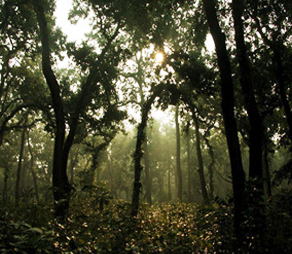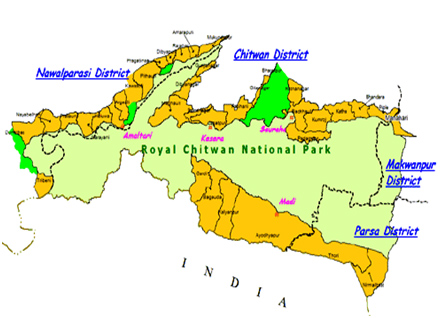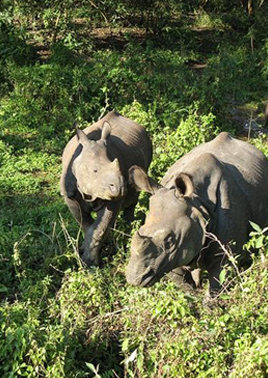- Home |
- Why With Us |
- About Us |
- Booking |
- Contact Us |
- Site Map

Chitwan National Park
Nepal’s most famous national park sits in the Terai lowlands close to the Indian border and covering some 932 sq km of hilly, deciduous sal forest and river flood plain. Amazingly diverse, the park is perhaps the best place to take an elephant-back safari in search of the famous one-horned Indian rhino and the royal Bengal tiger. With much other wildlife and birdlife to see and the interesting Tharu culture to discover no wonder it’s a magnet for visitors.
Lying 120km southwest of the capital Chitwan is Nepal's first national park, being established in 1973. Covering an area of 932 sq km the park lies between the Rapti, Narayani and Reu Rivers edging south of the Reu towards the border with India. Park headquarters are at Sauraha, a popular accommodation centre and from here the authorities manage the land and its animals. The park was granted World Heritage Site status in 1984.
Should you prefer to visit Chitwan as part of an overland jeep safari and tailor it into an itinerary that may include other parts of the south of Nepal, for example Lumbini, or see Chitwan as part of a tour to Pokhara, email us with a request for a custom designed itinerary.
Largely made up of flood plain, sal forest, marshes, grassland and hills the park provides the perfect habitat for more than 300 of the endangered Indian one-horned rhinoceros and harbours one of the largest populations of the critically threatened Bengal tiger. Besides these there are four species of deer, leopard, sloth bear, wild boar, rhesus monkey, grey langur monkey, wild dog, small wild cats, the gaur (the world's largest wild cattle). Gangetic dolphin, Asian elephant, golden monitor and gharial crocodile can all be found.
For the bird-watcher the park is a paradise with an incredible 450 species recorded. Resident species include woodpeckers, hornbills, Bengal florican, red-headed trogons whilst Brahminy duck, pintails and bareheaded geese visit in winter and paradise flycatcher, Indian pitta and parakeets in the summer.
Parts of the all-inclusive package are elephant rides, jungle drives and nature walks as well as canoeing trips.
 The Terai area around Chitwan is the home of the indigenous Tharu people who traditionally live in longhouses of up to 150 people. Built of mud with lattice walls the Tharu principally grow barley, wheat maize and the staple rice, raising chickens, pigs, goats and ducks as well as fishing the rivers. Traditionally the walls of their homes were decorated with colourful paintings.
The Terai area around Chitwan is the home of the indigenous Tharu people who traditionally live in longhouses of up to 150 people. Built of mud with lattice walls the Tharu principally grow barley, wheat maize and the staple rice, raising chickens, pigs, goats and ducks as well as fishing the rivers. Traditionally the walls of their homes were decorated with colourful paintings.
Chitwan is five hours drive from Kathmandu. An old runway strip in Meghauli is also used for charter flights. There are seven world class safari lodges inside the park and numerous other hotels and lodges outside the park. Visitors to the park are taken on jungle safaris on elephant back, jeeps and nature walks as well as boat rides in the Narayani and Rapti rivers. The park headquarters at Kasara is 21Km from Bharatpur which is 20 minutes by air or 146 km by road from Kathmandu. The best seasons to visit the park are from October to February when it's not too hot.
Features
The park consists of a diversity of ecosystems-including the Churia hills, Ox-bow lakes, and the flood plains of the Rapti, Reu and Narayani Rivers. The Churia hills rise slowly towards the east from 150 m. to more than 800 m. The western portion of the park is comprised of the lower but more rugged Someshwor hill. The park shares its eastern boundary with the Parsa Wildlife Reserve.
Climate
The park has a range of climatic seasons each offering a unique experience. October through February with average temperatures of 25oc offer an enjoyable climate. From March to June temperatures can reach as high as 43oC. The hot humid days give way to the monsoon season that typically lasts from late June until September, Rivers become flooded and roads are impossible.
of 25oc offer an enjoyable climate. From March to June temperatures can reach as high as 43oC. The hot humid days give way to the monsoon season that typically lasts from late June until September, Rivers become flooded and roads are impossible.
In late January, local villagers are allowed to cut thatch grasses to meet their need, which offers a better viewing of wildlife to visitors. From September - November and February -April, migratory birds join the residential birds and creating spectacular bird watching opportunities. While the monsoon rains bring lush vegetation, most trees flower in late winter. The palash tree, known as the "flame of the forest' and silk cotton tree have spectacular crimson flowers that can be seen from a distance.
Fauna:
The wide range of vegetation types in the Chitwan National Park is haunt of more than 700 species of wildlife and a not yet fully surveyed number of butterfly, moth and insect species. Apart from King Cobra and Indian rock python, 17 other species of snakes, Indian starred tortoise and monitor lizards occur. The Narayani-Rapti river system, their small tributaries and myriads of oxbow lakes is habitat for 113 recorded species of fish and mugger crocodiles.
Mammals
The Chitwan National Park is home to at least 43 species of mammals including Royal Bengal Tiger, Leopards, fishing cats, jungle cats, clouded leopards, leopard cats, marbled cats, golden jackals, Indian wild dogs, sloth bears, Bengal foxes, Spotted linsangs, palm civets, Large and Small Indian civets, several species of mongoose, binturongs, honey badgers and yellow-throated martens roam the jungle for prey. Striped hyenas are rare and prevail on the southern slopes of the Churia Hills. Smooth-coated otters inhabit the numerous creeks and rivulets. Since 1973 the population has recovered well and increased to 544 animals around the turn of the century. The Chitwan population of the world's largest wild cattle species has increased from 188 to 296 animals in the years 1997 to 2007. In addition, numerous wild boars, sambar deer, Indian muntjac, hog deer and herds of chital inhabit the park. Four-horned antelopes reside predominantly in the hills. Furthermore rhesus monkeys, hanuman langurs, Indian pangolins, Indian porcupines, several species of flying squirrels, black-naped hares and endangered hispid hares are present.
cats, clouded leopards, leopard cats, marbled cats, golden jackals, Indian wild dogs, sloth bears, Bengal foxes, Spotted linsangs, palm civets, Large and Small Indian civets, several species of mongoose, binturongs, honey badgers and yellow-throated martens roam the jungle for prey. Striped hyenas are rare and prevail on the southern slopes of the Churia Hills. Smooth-coated otters inhabit the numerous creeks and rivulets. Since 1973 the population has recovered well and increased to 544 animals around the turn of the century. The Chitwan population of the world's largest wild cattle species has increased from 188 to 296 animals in the years 1997 to 2007. In addition, numerous wild boars, sambar deer, Indian muntjac, hog deer and herds of chital inhabit the park. Four-horned antelopes reside predominantly in the hills. Furthermore rhesus monkeys, hanuman langurs, Indian pangolins, Indian porcupines, several species of flying squirrels, black-naped hares and endangered hispid hares are present.
Birds
Every year dedicated bird watchers and conservationists survey bird species occurring all over the country. In 2006 they recorded 543 species in the Chitwan National Park, much more than in any other protected area in Nepal and about two-thirds of Nepal's globally threatened species.
Especially the park’s alluvial grasslands are important habitats for the critically endangered Bengal florican, the vulnerable lesser adjutant, grey-crowned prinia, swamp francolin and several species of grass warblers. The near threatened Oriental darter is a resident breeder around the many lakes, where also egrets, bitterns, storks and kingfisher abound. The park is one of the few known breeding sites of the globally threatened Indian spotted eagle. Apart from the resident birds about 160 migrating and vagrant species arrive in Chitwan in autumn from northern latitudes to spend the winter here, among them are the Greater Spotted Eagle, Eastern Imperial Eagle and Pallas's Fish-eagle. Common sightings include Brahminy ducks and goosanders. Large flocks of bar-headed geese just rest for a few days in February on their way north. As soon as the winter visitors have left in spring, the summer visitors arrive from southern latitudes. The calls of Indian cuckoos herald the start of spring. The colourful Bengal Pittas and several sunbird species are common breeding visitors during monsoon. Among the many flycatcher species the Paradise flycatcher with his long undulating tail in flight is a spectacular sight.
Attractions:
The park itself is the main attraction, however there is also an elephant breeding centre 3km west of Sauraha and the Tharu villages are also interesting to visit; in Sauraha there is a tourist-orientated Tharu show at the Tharu Culture Program building.
Activities:
The chief attraction is of course an elephant-back safari in search of the wildlife and indeed several such excursions should be undertaken. Most people stay for 2 nights which allows for this, but if you have time a longer stay is recommended. Many of the lodges on the outskirts of the park are very comfortable and provide great places to spend several days even if the wildlife is not your prime interest. Lodges inside the park are more remote and some are very posh indeed; most are closed during the monsoon season as access roads are impassable. Canoe trips of the Rapti can be arranged as can 4wd safaris into the park. Cycling is a great way to explore outlying Tharu villages and get to the elephant breeding centre.
Facilities
The display at the visitor centre at Sauraha provides fascinating information on wildlife and conservation program. The women's user groups' souvenir shop offers a variety of handicrafts and other local products for gifts and souvenirs. Inside the park, there are 7 resorts run by park concessionaires that can provide lodging and access to wildlife activities. Various resorts and lodges situated outside the park also offer variety of services.
Accommodation: The ideal way to see Chitwan is by staying in one of the luxury lodges within the park. All lodges offer accommodation in either, rooms, bungalows or tented camps. Among the luxury lodges are a real institutions, most in business for twenty to nearly forty years, namely Gaida Wildlife Camp, Chitwan Jungle Lodge, Machan Paradise View and one with the best reviews specifically on account of offering the highest standard of naturalists, Tiger Tops.
How to Get There:
The park is accessible by car or bus on the Kathmandu-Mugling-Narayanghat Highway and or through Mahendra Rajmarg Highway from Hetauda. It is about 6 hour's drive from Kathmandu to Narayanghat. Local buses are available to Tadi Bazar which is about an hour drive from Narayanghat. A 6 km walk or bullock cart ride brings the visitors to Sauraha, the park entrance. There are also air services from Kathmandu to Meghauli for US$82 each way and Bharatpur US$65. Local buses are available from Narayanghat to Park HQ, Kasara.
To make the most of your visit you need at least three nights, four days to make the visit from Kathmandu. As transfers by road can take as much as seven hours from Kathmandu, best way to visit Chitwan is by half an hour flights from Kathmandu to either Bharatpur or Meghauli, transfer to the park from there, and return the same way.
Chitwan National Park climate data
| Jan | Feb | Mar | Apr | May | Jun | Jul | Aug | Sep | Oct | Nov | Dec | |
| Precipitation (mm) | 20 | 16 | 25 | 65 | 147 | 389 | 714 | 499 | 387 | 106 | 8 | 16 |
| Temperature (°C) | 23 | 25 | 31 | 35 | 36 | 35 | 33 | 33 | 33 | 31 | 28 | 24 |
Entry fees into Royal Chitwan National Park:
National Park entry fee per person per day:
- For Nepali Nationals Rs 20
- For SAARC Nationals Rs 200
- For Foreign Nationals Rs 500
- Children under 10 years Free
- Elephant ride for about 2 hrs. - Rs 550 - (Nepali's Rs 100)
- Fishing permit - Rs 300 - (Nepali's Rs 20)
- Camping per night per person - Rs 300 - (Nepali's Rs 20)
- Guided jungle walk - Rs 250/400 for half day/full day - (Nepali's Rs 20)
- Canoeing - Rs 230 per person
- 4WD safari - Rs 650 per person
- Gharial crocodile breeding centre - included in the park entrance fee
- Elephant breeding centre - included in the park entrance fee
- Lodges offer all-inclusive packages for 2 to 4 days for those who want everything pre- organised by the lodge guides.

National Parks

Wildlife Reserve



